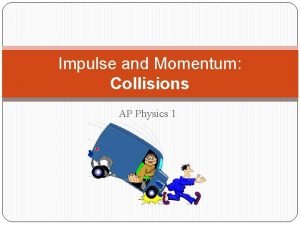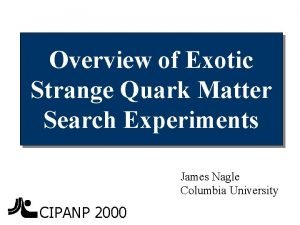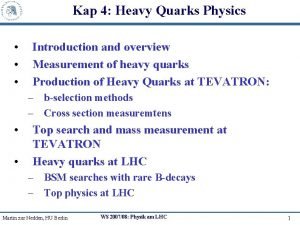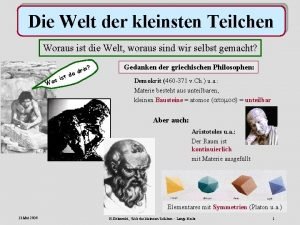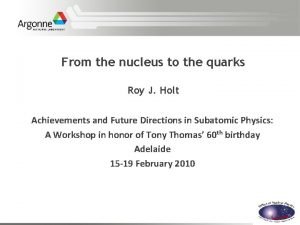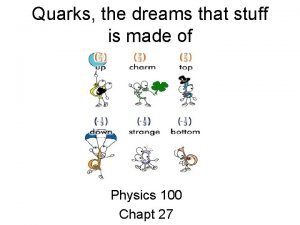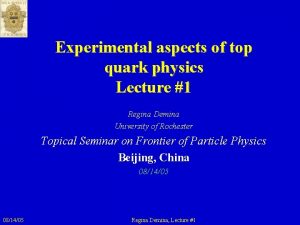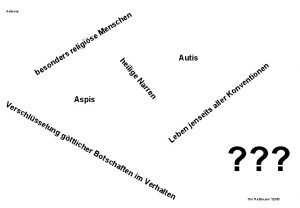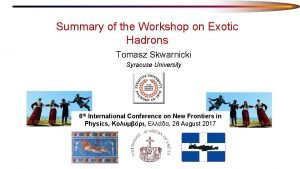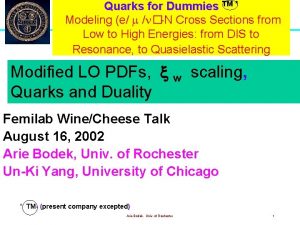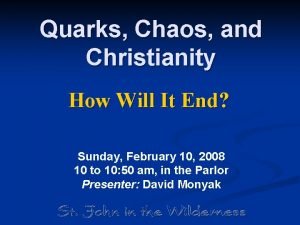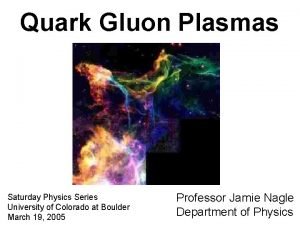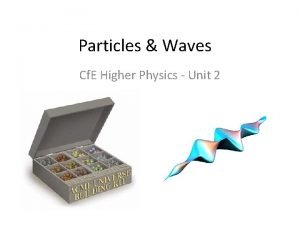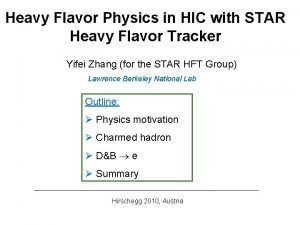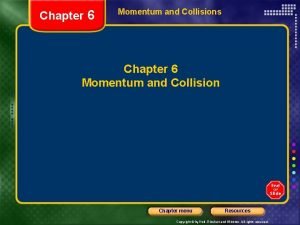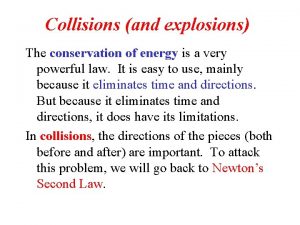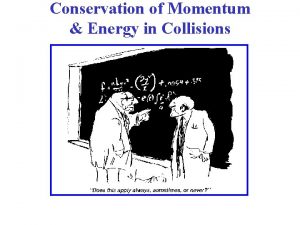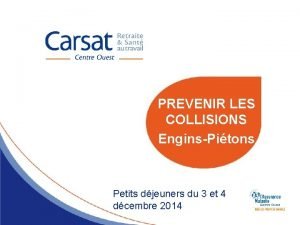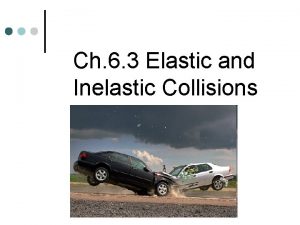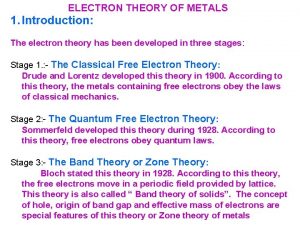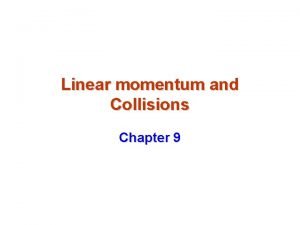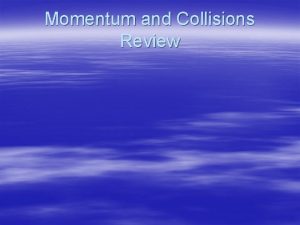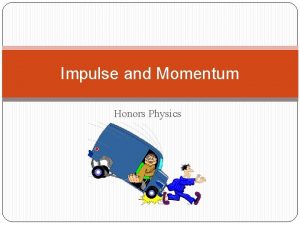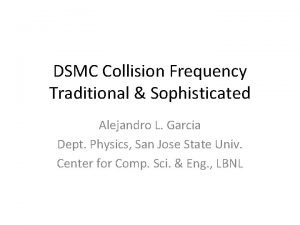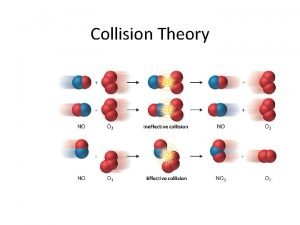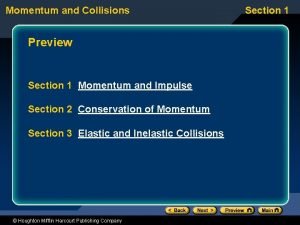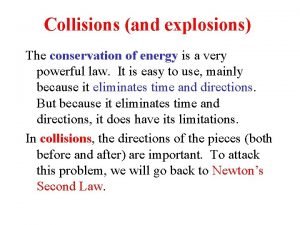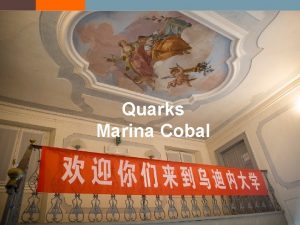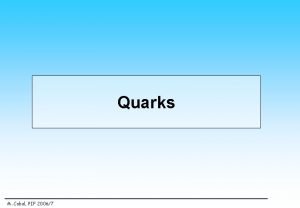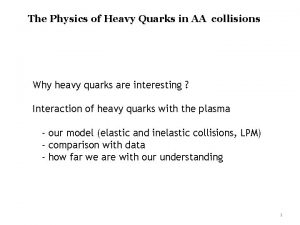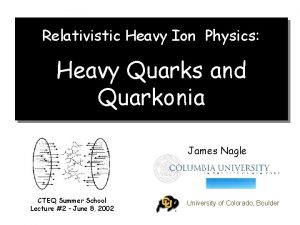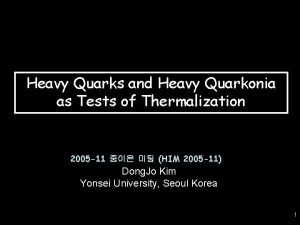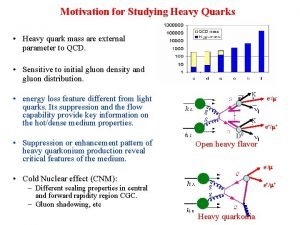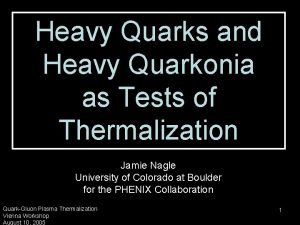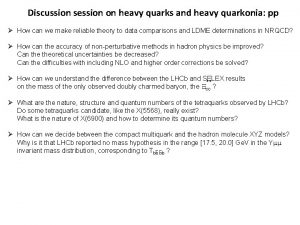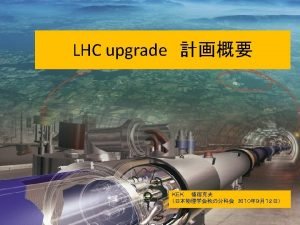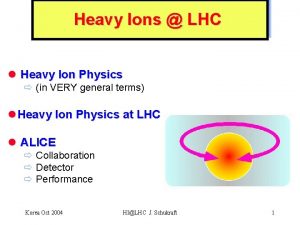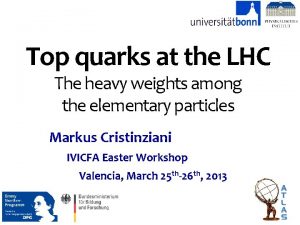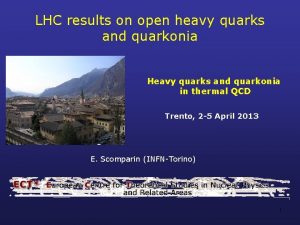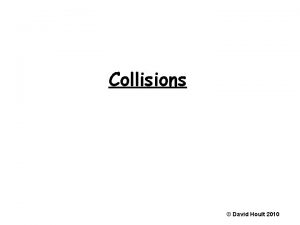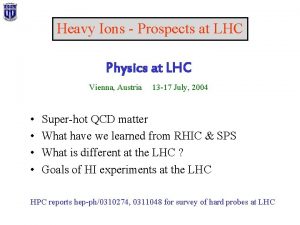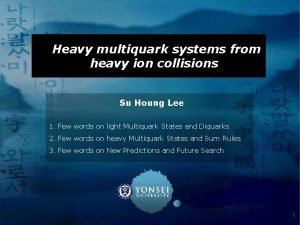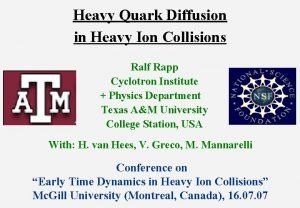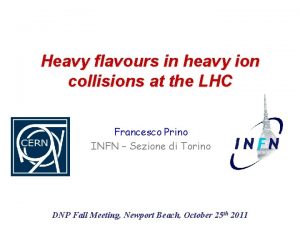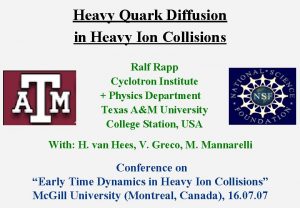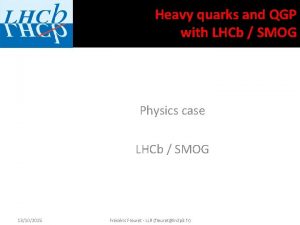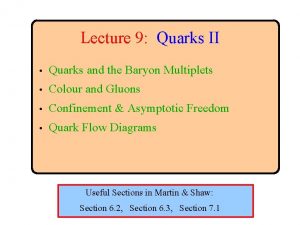The Physics of Heavy Quarks in LHC collisions


































- Slides: 34

The Physics of Heavy Quarks in LHC collisions How to detect a plasma of quarks and gluons and its degrees of freedom? Why are heavy quarks interesting ? Interaction of heavy quarks with the quark gluon plasma - our model (elastic and inelastic collisions, LPM) - comparison with LHC data - interpretation of the results - state of the art of the transport approaches - what have we learned and where are the open questions - c cbar interaction with the plasma - Boltzmann versus Fokker Planck 1

The existence of a quark gluon plasma and the kind of transition towards the hadronic world has been predicted by lattice gauge calculations has been claimed to be seen in experiments (Science) Why this is still a topic ? because we want to know the degrees of freedom of the plasma and their interaction Light hadrons: their multiplicity follows a gas of T = 158 Me. V Hadronic rescattering spoils spectra no info about plasma Possible probes: collective variables : ridge, elliptic flow ( hydro, only EOS) γ, dileptons jets heavy quarks (D, B Mesons, J/psi, Y) no equilibrium with plasma 2

What makes heavy quarks (mesons) so interesting? - produced in hard collisions(distribution: FONLL confirmed by STAR) - high p. T: no equilibrium with plasma particles - not very sensitive to the hadronisation process at high p. T Ideal probe to study properties of the QGP during its expansion Caveat: two major ingredients: expansion of the plasma AND elementary cross section (c(b)+q(g) ->c(b)+q(g)) (ar. Xiv: 1102. 1114 ) Heavy quark physics not decoupled from light quark physics 3

Complicated process: creation->propagation c ->hadronization ->propagation D Our approach : • We assume that p. QCD provides the tools to study the processes We want to • model the reaction with a minimum of approximations: exact Boltzmann collisions kernel, no probably unrealistic Fokker Planck approx. (1309. 7930) • take into account all the known physics with • no approximations of scattering processes (coll+ radiative) • make connection to the light quark sector (v 2 jets particle spectra) by embedding the heavy quarks into EPOS (LHC) • This serves then as a benchmark • deviation from data points towards new physics Problem: at the moment only two obs: RAA and v 2 available 4

Nantes approach: Elastic heavy quark – q(g) collisions Key ingradients: p. QCD cross section like q. Q -> q. Q p. QCD cross section in a medium has 2 problems: a) Running coupling constant b) Infrared regulator m. D regulates the long range behaviour of the interaction Neither g 2= 4 α(t) nor κ m. D 2= are well determined standard: α(t) =is taken as constant or as α(2πT) Collisional Energy α Loss κ =1 and =. 3: large K-factors (≈510) are necessary to describe data

A) Running coupling constant “Universality constraint” (Dokshitzer 02) helps reducing uncertainties: 0801. 0595 Peshier IR safe. The detailed form very close to Q 2 = 0 is not important does not contribute to the energy loss Large values for intermediate momentumtransfer T 1. 1 Tc T 1. 5 Tc V=F KZ P. R. D 71 (2005) V=U KZ, Po. S LAT 2005 (2005) 192 Collisional Energy Loss Lattice

PRC 78 014904, 0901. 0946 B) Debye mass If t is small (<<T) : Born has to be replaced by a hard thermal loop (HTL) approach For t>T Born approximation is (almost) ok hep-ph/0607275 (Braaten and Thoma PRD 44 (91) 1298, 2625) for QED: Energy loss indep. of the artificial scale t* which separates the regimes We do the same for QCD (a bit more complicated) Phys. Rev. C 78: 014904 Result: κ ≈ 0. 2 much lower than the standard value Collisional Energy Loss 7

C) Inelastic Collisions Low mass quarks : radiation dominantes energy loss Charm and bottom: radiation of the same order as collisional 4 QED type diagrams Commutator of the color SU(3) operators M 1 -M 5 : 3 gauge invariant subgroups 1 QCD diagram Radiative Energy Loss 8 M QCD dominates the radiation

MSQCD in light cone gauge In the limit the radiation matrix elements factorize in kt , ω = transv mom/ energy of gluon E = energy of the heavy quark Emission from g Emission from heavy q leading order: no emission from light q heals colinear divergences m=0 -> Gunion Bertsch Energy loss: x=� /E 9 We include Landau-Pomeranschuk Migdal effect

Calculations for LHC Initialization: FONLL distribution of c and b QGP : EPOS 2 Interaction QGP-heavy quarks: elastic collisions (collisional energy loss) (K ≈ 2) elastic collisions + and gluon emission (radiative energy loss) +LPM Hadronisation: Coalescence for low pt heavy quarks Fragmentation for high pt heavy quarks Hadronic rescattering is small 10

Energy loss tests the initial phase of the expansion RHIC: D mesons Elastic + radiative LPM 0 -10% 0 -80% No form difference between coll and coll + rad 11

LHC : EPOS event generator v 2 tests the late stage of the expansion Energy loss tests the initial phase of the expansion 3 options : Collisions only K factor = 1. 5 Collision and radiation K = 0. 8 Radiation only K= 1. 8 RAA and v 2 for coll and coll + radiative about the same B much more suppressed 12

Heavy quarks show also a finite v 3 and finite higher moments What can one learn from these results? v 2 decreases with centrality -> understandable with the decrease of ϵ 2 v 3 independent of centrality -> fluctuations 13

Analysis of the results 14

The different RAA of D and B mesons seem to be verified experimentally (by comparing two different experiments) 15

Where do the finite vi come from? z In the ideal world the plasma Should have only v 2 Plasma to be studied Reaction plane y x In the real world (EPOS) the plasma has all kinds of moments vi the vi impair are fluctuations v 3 corresponds to a Mercedes Star 16

Very surprising : v 2 /ϵ 2 : same for light hadrons and D mesons Light quarks: hydro-dynamical pressure caused by spatial eccentricity v 2 /ϵ 2 const for ideal hydro, centrality dependent for viscous hydro Heavy quarks: No initial v 2 (hard process) v 2 only due to interaction with q and g v 2 of heavy quarks is created later, measures the interaction time Bottom quarks are too heavy to follow 17

More detailed analysis of the flow 20% of v 2 due to the hadronisation uncertainty fragmentation or coalescence Verification that collective flow creates v 2 Artificial elimination of the collective flow High momentum: different path length in and out of plane 18

State of the Art of the Field Evidently there are many approaches which describe the two key observables RAA and v 2. despite of quite different physics input 19

Models studying RAA and v 2 simultaneously assume that the passage through QPG medium can be modeled by independent collisions (besides LPM) Born type cross sections and FONLL initial distribution of heavy quarks but q - different cross section (collisional, radiative or both, b and c) collisional radiative q q q different coupling constants α(Q 2 ), α(T), α= const different masses in the propagators (form of the propagators) different masses in exit and entrance channel m 0 , m(T) q q q different initial QGP different expansion scenarios (viscous, ideal hydro, gas of q, g) different hadronization ( coalescence, fragmentation) RAA and v 2 are not sufficient to nail down all these model parameters

All agree on: q q FONLL is the proper initial condition (shadowing? ? ) p. QCD cross sections (α=0. 3 , m=m 0 ) are too small to explain data Confirmed by lattice calculations : Spatial diffusion coefficient PRC 90, 051901 A= drift coefficient PRC 90, 064906 21

How to compare different approaches and what is the result? Sequence of meetings: Berkeley I and II EMMi/ GSI Leiden 22

Different numerical approaches Fokker-Planck Langevin Brownian Motion Boltzmann collision integral Advantage: - very general approach - Whole kinematics of HQ is reduced to (mom. dep. ) drag and diffusion coefficient related by the Einstein relation Advantage: - Interaction between HQ and partons is related to the underlying Lagrangian (Feynman diagrams) -> microscopic interpretation possible - Allows for the calculation of drag and diffusion coeff. independently Drawback: - Physics very difficult to asses if coeff. not determined from an underlying theory - Need lattice data, or underlying theory - otherwise it is a fit Drawback: - Assumes asympt. free states (low density) - Presently only effective Lagrangians Strategy: Boltzmann type models calculate drag and diffusion coefficients which can be compared with the Langevin approaches

How to advance to compare very different theories? As far as collisions are concerned: Start with transport coefficients = Reaction of a fast particle on a thermal environment Drag coefficient: q reduces the cross section information to a function of 2 variables: p, T q can be calculated for every cross section -> makes cross sections comparable 24

Example : EPOSHQ and PHSD EPOSHQ 1: 2 final state mass 1: 3 α(T) <-> α(Q 2 ) 3: 5 propagator DQPM/ PHSD : Late energy loss 25

c-quarks reaction to the QGP environment rather differently in the diff. codes large momentum loss close to Tc like DQPM(PHSD), Catania, Berkeley large energy loss at T > Tc Nantes, p. QCD like , TAMU Only the integral over the energy loss can be measured !! (obviously the same because all describe data) Elastic energy loss and c-quarks only

Treatment of non-p. QCD features will still need a lot of discussions among us and with the lattice community but what we can do immediately is to use the right (complicated) tools for plasma expansion for the cq and cg interaction Different models For the QGP expansion Different descriptions of the c cbar - QGP interaction Fokker-Planck (FP)<->Boltzmann(BM) Catania group PRC 90(14)044901 EMMI workshop proceedings 27

Conclusions All experimental midrapidity RHIC and LHC data are compatible with the assumption that p. QCD describes energy loss and elliptic flow v 2 of heavy quarks. Special features running coupling constant adjusted Debye mass Landau Pomeranschuk Migdal QGP expansion QGP must be controlled by light hadrons (EPOS) Data do not allow for discriminating between different p. QCD processes: radiative and collisional energy loss First results about the physics are now possible - b/c results - Origin of the flow (p. T) - Effective degrees of freedom 28 of the QGP Conclusion

But There are several approaches which reproduce RAA and v 2. the presently only available data. We measure only integrated energy loss in an expanding QGP It can be obtain in many ways l. QCD EOS does not help a lot: masses are only one of the ingredients l. QCD spatial diffusion coeff -> p. QCD does not work We have to wait for new observables (identified b, Δφ of Dbar. D, Dh, high precision v 2, DS) and more input from l. QCD What transport people can do: Using for the QGP expansion only models which reproduces data in the light quark sector Abandon Fokker-Planck approaches and concentrate on the much more demanding Boltzmann collision kernel We have to assure a kind of quality control 29

Collaborators Nantes Vitalii Ozvenchuck Pol Gossiaux Thierry Gousset Marlene Nahrgang Luuk Vermunt Klaus Werner Frankfurt Hamza Berrehrah Elena Bratkovskaya Pierre Moreau Taesoo Song Giessen Wolfgang Cassing Duke Steffen Bass LBL Shanshan Cao Xin-Nian Wang 30

From Boltzmann to Fokker – Planck One start with the Boltzmann collision term and forms mean values : The drag is given by and the diffusion by These are the coefficients need for the Fokker-Planck equation

4 Observations a) Whereas the Boltzmann integral brings the heavy quarks for t →∞ to a thermal equilibrium, the Fokker Planck equation does this only if AND A and B related by Einstein relation This is (by far) not the case if A and B are calculated from Boltzmann collision Kernel This leaves three options ( ) to relate Fokker Planck to Boltzmann different choices have been made -> different results b) Time evolution of f(p, r, t) of c with Fokker Planck is very different as compared to Boltzmann eq. (Das et al. PRC 90(14)044901) (here B is used to determine drag) FP FP m. D ≈ m. Dlatt Boltzmann

For realistic Debye masses (Kaczmarek et al. (1206. 19912)) to reproduce data: we need by a factor of 2 different drag and diffusion coefficient Depending on whether we apply FP or Boltzmann. LV: diffusion coeff 52% of that of Boltzmann

34
 Impulse and acceleration
Impulse and acceleration Ratey rational functions
Ratey rational functions Hadrons
Hadrons Quarks
Quarks Myonevent
Myonevent Aus was bestehen quarks
Aus was bestehen quarks Nucleus
Nucleus 6 types of quarks
6 types of quarks Quarks regina
Quarks regina Proton neutron quarks
Proton neutron quarks Quarks und co autismus selbsttest
Quarks und co autismus selbsttest Color quarks
Color quarks Quarks for dummies
Quarks for dummies Big crunch
Big crunch Proton neutron quarks
Proton neutron quarks 6 types of quarks
6 types of quarks Heavy flavor physics
Heavy flavor physics Chapter 6 momentum and collisions
Chapter 6 momentum and collisions Collisions and explosions
Collisions and explosions Cross traffic is eliminated on controlled access expressway
Cross traffic is eliminated on controlled access expressway Common velocity after collision formula
Common velocity after collision formula Prévention des collisions engins-piétons
Prévention des collisions engins-piétons Inelastic collision examples real world
Inelastic collision examples real world Perfectly inelastic collision
Perfectly inelastic collision Types of collision
Types of collision Success of classical free electron theory
Success of classical free electron theory A freight train is being assembled in a switching yard
A freight train is being assembled in a switching yard Inelastic collision
Inelastic collision A moderate force will break an egg
A moderate force will break an egg Type of collision
Type of collision Collision frequency formula
Collision frequency formula Collision theory diagram
Collision theory diagram Collisions
Collisions Collisions and explosions
Collisions and explosions Is momentum conserved in all collisions
Is momentum conserved in all collisions
